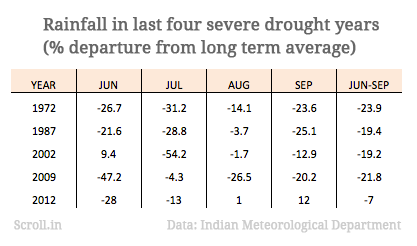The southwest monsoon did touch Kerala on June 6, but it was five days later than normal and rainfall so far has been 40% below normal. The average rainfall in June is 124.5 mm, but this year the country has received only 74.4 mm so far.
"We predict that the monsoon will pick up by the second half of July," said Nabansu Chattopadhyaya, deputy director general at the Indian Meteorological Department. One needs to wait until the end of July in order to tell whether we are headed for a drought, he said.
In 2012, for example, rainfall in June was 28% below normal, but by July the monsoon had recovered and the total rainfall for that period rose to 92% of the long-term average.
From June onwards, the southwest monsoon rapidly moves across India all the way to the northeast before receding in September. It covers a huge swathe of the country and is crucial to its farm and allied sectors, which contribute to about a fifth of GDP but employ more than half the population.
Still, the situation is worrying. Several districts in Maharashtra, Gujarat, Madhya Pradesh, Andhra Pradesh, Uttarakhand, Punjab and Orissa are reeling under moderately to severely arid conditions, according to the Indian Meteorological Department itself, and this number is likely to increase over the next week. Farmers across the country are waiting for the rainfall needed to sow their crops.
Rainfall has been scanty or deficient in 42% of the country, causing the government to declare this a semi-drought year. To calculate deficiency, the benchmark is the long-term average annual rainfall since 1901.

In order to determine whether there is a drought, experts make fortnightly assessments of water availability, soil moisture stress and aridity to calculate something called the standard precipitation index, which tells them whether a region has drought conditions.
Experts also distinguish between hydrological and agricultural droughts. The first involves a drying up of rivers, lakes and groundwater resources for general use, such as for drinking or for industry. An agricultural drought refers to a lack of basic moisture in the soil, due to which crops will not be able to grow without external irrigation.
If there is good rain in July, India will be able to avert a hydrological drought. If rainfall continues to be abundant until August, we might also escape an agricultural drought.










